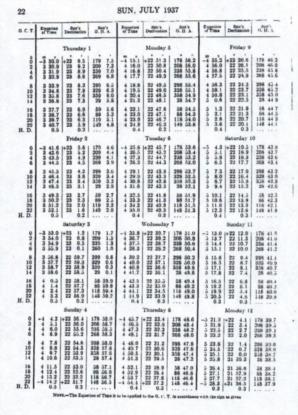
NavList:
A Community Devoted to the Preservation and Practice of Celestial Navigation and Other Methods of Traditional Wayfinding
Semi-diameter in the Nautical Almanac
From: Gary LaPook
Date: 2009 Dec 15, 00:50 -0800
From: Gary LaPook
Date: 2009 Dec 15, 00:50 -0800
We are all familiar with the semi-diameter of the sun and of the moon being tabulated on each of the daily pages of the Nautical Almanac. My question is "why?" There is no place where you use this bit of information when using the N.A. This information would be useful if the sextant corrections were made separately but both the moon and sun correction tables in the N.A. combine semi-diameter with the refraction and parallax in altitude corrections in just one table so there is no place to input the S.D. There has not always been a listing of S.D. for the sun, see the attached page from the 1937 N.A. I am also curious why the sun correction table has only two tabulations allowing for only two S.D. values when the S.D. of the sun includes six different values during the year from15.8 to 16.3 minutes. This unnecessarily limits the accuracy of the sun corrections. The horizontal parallax of the sun is 8.8 seconds or just slightly less than .15 minutes. Looking at the sextant correction table for the sun for an altitude of zero degrees for October to March we find a value for the lower limb of -18.2'. This includes the refraction correction of -34.5' and the horizontal parallax of .15'. So by backing out these value we can see that the semi-diameter used for this correction table is 16.15' while the S.D during this period includes four values from 16.0' to 16.3' building in up to a .15' error. For the period of April to September the S.D. varies form 15.8' to 16.0' but the S.D. used in the correction table is 15.95' also building in an error up to .15'. So using the sun's actual S.D. with the refraction table for stars should produce better accuracy but then you have to account for the sun's parallax in altitude. A separate table for the sun's parallax in altitude would be quite simple. To an accuracy of .1' the sun's horizontal parallax of 8.8 seconds rounds down to .1'. Since the parallax in altitude varies with the cosine of the altitude the parallax in altitude table, to .1' precision, would show .1' for altitudes of zero to 70 degrees and zero minutes above 70 degrees. Frank seems to be an expert on the N.A. maybe he can explain this. gl -- NavList message boards: www.fer3.com/arc Or post by email to: NavList@fer3.com To , email NavList+@fer3.com







